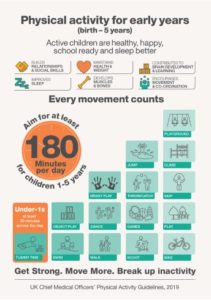Getting pre-schoolers moving 3 – 5 years
Pre-schoolers want and need to be physically active; they have lots of energy to use and they need to experience all kinds of different movement to develop their strength, balance and coordination.
Being active support and encourages development of gross and fine motor skills, which they’ll need to get them school ready.
Pre-schoolers should be active for 180 minutes (3 hours) a day. It might sound a lot, but it soon adds up from lots of little activities throughout the day. It doesn’t always have to be structured activities and can be achieved through play and exploration.
Top tips for getting pre-schoolers moving
Kicking and throwing
Provide your child with different objects to kick with their feet and throw with their hands. Rolled up socks, balls, balloons and scrunched up tea towels all work. See long they can keep a balloon in the air using different parts of their body. Throwing will help their arms and hands gain strength, which is important for when they learn to write – encourage different types of throwing like underarm and overarm.
Sitting
Sitting in the W-position is common young children. W-sitting is when a child sits on their bottom with their knees bent and feet positioned outside of their hips. If you’re standing above your child, you will see their legs and body make the shape of a W. When children W-sit for longer periods of time, they are at greater risk of hip dislocation, limited trunk/core strength, lack of cross body movements, increased muscle tightness. Instead encourage your pre-schooler to sit with their legs in front of them with a straight of them. When they sit in a chair make sure their legs can touch the floor. If I’m they are sat on a chair which is too high for their legs, put a ‘step’ under their feet.
Make challenges
Set your pre-schooler challenges against the clock, or set them up an obstacle course, encouraging them to go backwards, sideways, fast or slow, jumping, hopping, skipping and balancing.
Use Music
Pre-schoolers love music especially if they can move to it with you. Try different party games like musical statues. As they get older take it in turns to make up different funny moves and dances.
Gaining independence
Let your child have a go at putting their socks and shoes on or putting their coat or jumper on. They can start to help you around the house with simple cleaning tasks, tidying toys away or making their own bed.
Exploration
Children love going on adventures, but it doesn’t always have to be outside – they can explore, climb and crawl without even leaving the house. Grab a cardboard box so they can hide in it and peek out at you, you could even make a home-made den using bedsheets and cushions.
Encourage the use of both sides of their body
Help your pre-schooler to use both sides of their body at the same time, this will help with their reading and writing. Sing the head, shoulders, knees and toes song and help your child do the actions themselves or play ‘Simon says’.
Risk taking
As your pre-schooler gets stronger and more coordinated, they will get braver with the types of movements they do. They’ll probably want to climb more and move faster, this is fine as long as you are in a safe environment and you can keep an eye on them. It’s likely they’ll fall over sometimes, that’s okay it will help them learn and develop. Allow them walk and run on different surfaces like sand, grass or concrete.
Balancing
Try making a balancing path for me to follow, or a tightrope for me to walk along with chalk or tape, see if I can do it without stepping off, make it shorter or longer, or send it in different directions.
Download the recommendations for physical activity from birth to 5 years


